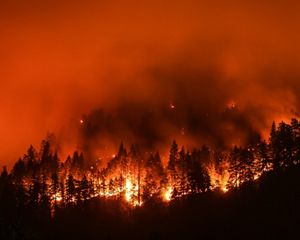The Nature Conservancy and The Aspen Institute Partner on Wildfire Resilience
New Collaboration to Gather Input, Make Recommendations for Safer Communities and Healthier Forests
Media Contacts
-
Jay Lee
The Nature Conservancy
Mobile: 301-640-1615
Email: jay.lee@TNC.ORG -
Clarke Williams
Aspen Institute
Phone: 703-554-7378
Email: Clarke.williams@aspeninstitute.org
The Nature Conservancy and the Aspen Institute have launched a new partnership to improve wildfire resilience in the United States. With more than 80 large U.S. wildfires currently threatening communities across 13 states and each wildfire season promising to be worse than the last, the two organizations are joining forces to convene leading voices over the coming year to gather expertise and input from a full range of stakeholders on the topic. Stakeholders will include local, state and federal governments as well as nongovernmental organizations, utilities, insurance companies and other businesses.
These convenings will inform a second phase of the partnership, where the two organizations will make recommendations for a comprehensive approach to improving wildfire resilience – and therefore community safety and forest health – to policymakers and other leaders.
“The current strategy of dealing with catastrophic wildfires isn’t working, and, in fact, is leaving us further and further behind,” said Lynn Scarlett, chief external affairs officer at The Nature Conservancy. “It is time to change the paradigm and create a new trajectory for how we manage and prepare for wildfire impacts. There’s no time to waste, as the risks from wildfires are painfully clear in American communities right now. We’re eager to address the issue with a comprehensive approach to improving America’s wildfire resilience—one with input and efforts from all levels of government, the private sector, communities and other stakeholders. There’s no better partner for us than the seasoned thought leaders at the Aspen Institute, and we’re grateful for their collaboration.”
“As more than 1.3 million acres burn in the western U.S., we are seeing and experiencing the devastating impacts of the climate crisis on the American landscape right now—a crisis that demands we act today and not in the distant future we once imagined,” said Greg Gershuny, executive director of the Aspen Institute's Energy and Environment Program. “To protect our communities, build wildfire resilience and ensure the health of our forests, we must seek out new and innovative solutions and management practices. With our partners at The Nature Conservancy and the power of collaboration our convenings will foster among experts and practitioners, we can build a comprehensive national plan that centers on those most affected by severe wildfire seasons.”
Funding for Wildfire Resilience
It is time for bold policy action to reduce risks of catastrophic wildfires.
See What We're RecommendingThe partnership will build on existing work. A new study from The Nature Conservancy found that an investment surge of $5 billion to $6 billion per year over the next 10 years is needed for the highest priority work of reducing wildfire risks and providing communities with much-needed resources for infrastructure and adaptation. It recommends increased investments and an improved focus on enhanced forest health, forest restoration and other strategies to reduce the risks of catastrophic wildfires while also creating jobs, economic opportunities and healthier air, land and water.
And, a recent analysis from The Nature Conservancy and Willis Towers Watson, the third largest insurance broker in the world, shows how ecological forest management, which reduces the risk of severe wildfires in fire-adapted forests, can be combined with insurance and significantly reduce insurance costs.
Last year, some 10 million acres burned in the United States, costing nearly $20 billion in damages, burning more than 17,000 structures and tragically claiming at least 46 lives. From the adverse health effects associated with smoke to the disruption of supply chains, power supplies, transportation and labor—the extensive costs of wildfires often disproportionately affect families with low incomes and few or no means to recover their livelihoods.
The trends continue to worsen as the American West, currently facing historic drought conditions, is getting warmer and drier. At the same time, wildfire resilience spending is not keeping pace with the increasing costs of wildfire suppression. In the last 10 years, federal suppression costs alone have grown by nearly 400 percent, while wildfire resilience investments have remained essentially flat.
“While the funding needs are great, a comprehensive solution requires more than dollars,” concluded Scarlett. “It requires rethinking land use planning, power and other infrastructure and more. Our partnership will bring together experts, stakeholders and decision makers to shape a comprehensive set of solutions.”
Bob and Soledad Hurst, as trustees of the Hurst Family Foundation, along with Melony and Adam Lewis, are key funders of The Nature Conservancy and Aspen Institute’s wildfire and forest resilience work.
The Nature Conservancy is a global conservation organization dedicated to conserving the lands and waters on which all life depends. Guided by science, we create innovative, on-the-ground solutions to our world’s toughest challenges so that nature and people can thrive together. We are tackling climate change, conserving lands, waters and oceans at an unprecedented scale, providing food and water sustainably and helping make cities more resilient. The Nature Conservancy is working to make a lasting difference around the world in 81 countries and territories (40 by direct conservation impact and 41 through partners) through a collaborative approach that engages local communities, governments, the private sector, and other partners. To learn more, visit nature.org or follow @nature_press on X.



